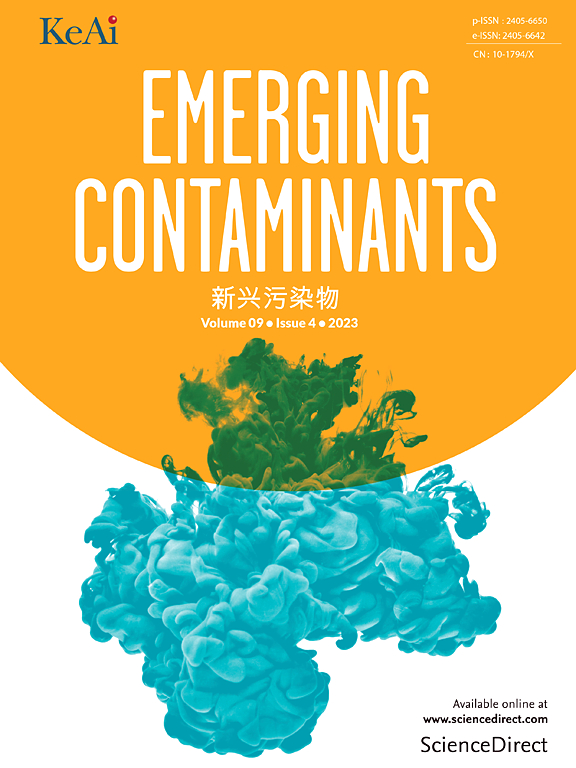Microplastics in settled indoor dust: Implications for human exposure
IF 6.9
2区 环境科学与生态学
Q1 ENVIRONMENTAL SCIENCES
引用次数: 0
Abstract
In recent years, microplastics (MPs) occurrence in indoor environments has raised significant concerns due to their distinctive physicochemical properties and potential toxicity. Indoor dust is well-documented as important vector for human exposure to emerging contaminants via inadvertent ingestion. Consequently, the main aim of the present study is to assess human exposure to MPs in settled indoor dust by determining concentrations, and characteristics (size, shape, and polymer type) of MPs in dust samples collected from houses (n = 30) and workplaces (n = 30) in Birmingham, UK. The average MPs concentrations were 155 ± 222 MP/mg in homes, and 125 ± 209 MP/mg in workplaces. Statistical analysis revealed the mean concentration of MPs in the studied homes was significantly higher than that in workplaces, which was attributed mainly to carpeting. In terms of morphology, various shapes of MPs (e.g., fiber, fragment, foam, foil) were identified, with fibres and fragments constituting ∼90 % of the identified MPs in all studied samples. Within the MPs particle size range (10–150 μm) investigated in the current study, the particle size fraction (50–100 μm) was predominant (>49 %) in all the studied samples, followed by particles >100 μm, with fibres having the largest average size (67 μm) among the detected MPs shapes. Polypropylene (PP) and Polyethylene Terephthalate (PET) were the most abundant polymer types in the studied samples, followed by Polyvinyl Chloride (PVC). Typical daily exposures of UK adults and toddlers to MPs through inadvertent ingestion of indoor dust were estimated at 56 and 103 MPs/day. The higher exposure of toddlers was exacerbated by their lower body weight with an estimated typical exposure of 9.7 MP/kg Bw/day, compared to 0.8 MP/kg Bw/day for adults. The higher ingestion exposure to MPs in toddlers raises concern over potential adverse health effects due to their incompletely developed immune and nervous systems.
室内尘埃中的微塑料:对人体暴露的影响
近年来,由于微塑料具有独特的物理化学性质和潜在的毒性,其在室内环境中的存在引起了人们的极大关注。有充分证据表明,室内灰尘是人类通过无意摄入而暴露于新出现的污染物的重要载体。因此,本研究的主要目的是通过确定从英国伯明翰的房屋(n = 30)和工作场所(n = 30)收集的灰尘样本中MPs的浓度和特征(大小、形状和聚合物类型)来评估人类对室内尘埃中MPs的暴露。家中MPs平均浓度为155±222 MP/mg,工作场所为125±209 MP/mg。统计分析显示,在被研究的家庭中,MPs的平均浓度明显高于工作场所,这主要归因于地毯。在形态方面,鉴定了各种形状的MPs(例如,纤维,碎片,泡沫,箔),在所有研究样品中,纤维和碎片占鉴定的MPs的90%。在本研究研究的MPs粒径范围(10-150 μm)内,在所有研究样品中,粒径分数(50-100 μm)占主导地位(> 49%),其次是粒径为>;100 μm的颗粒,在检测到的MPs形状中,纤维的平均粒径最大(67 μm)。聚丙烯(PP)和聚对苯二甲酸乙二醇酯(PET)是研究样品中最丰富的聚合物类型,其次是聚氯乙烯(PVC)。据估计,英国成年人和幼儿每天因无意中摄入室内灰尘而接触到MPs的典型量为56和103 MPs/天。幼儿较低的体重加剧了较高的暴露量,估计典型暴露量为9.7 MP/kg Bw/天,而成人为0.8 MP/kg Bw/天。由于幼儿的免疫和神经系统发育不完全,摄入较多的MPs引起了人们对潜在的不良健康影响的担忧。
本文章由计算机程序翻译,如有差异,请以英文原文为准。
求助全文
约1分钟内获得全文
求助全文
来源期刊

Emerging Contaminants
Medicine-Public Health, Environmental and Occupational Health
CiteScore
10.00
自引率
6.70%
发文量
35
审稿时长
44 days
期刊介绍:
Emerging Contaminants is an outlet for world-leading research addressing problems associated with environmental contamination caused by emerging contaminants and their solutions. Emerging contaminants are defined as chemicals that are not currently (or have been only recently) regulated and about which there exist concerns regarding their impact on human or ecological health. Examples of emerging contaminants include disinfection by-products, pharmaceutical and personal care products, persistent organic chemicals, and mercury etc. as well as their degradation products. We encourage papers addressing science that facilitates greater understanding of the nature, extent, and impacts of the presence of emerging contaminants in the environment; technology that exploits original principles to reduce and control their environmental presence; as well as the development, implementation and efficacy of national and international policies to protect human health and the environment from emerging contaminants.
 求助内容:
求助内容: 应助结果提醒方式:
应助结果提醒方式:


